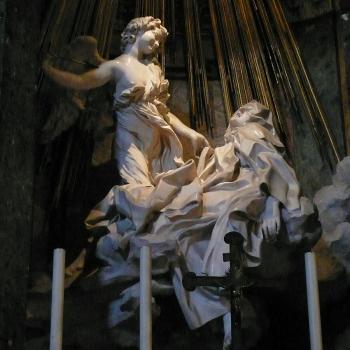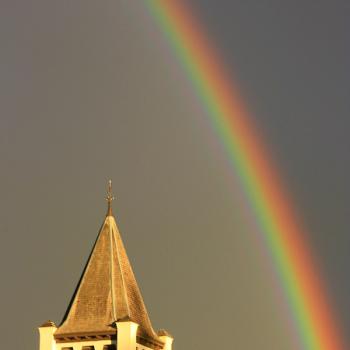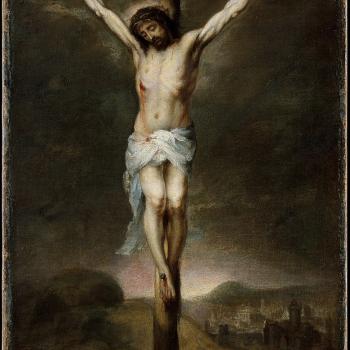At the end of the book I point out that we can’t predict all the ways that welcoming gay/queer/same-sex attracted Christians will change our churches. In both the book and “Coming Out Christian” I talk about some of the ways I hope the increasing visibility and inclusion of gay Christians will change the churches–and our whole culture–but this is not something you or I control. I doubt that the nascent g/q/ssa Christian communities will agree on all these changes; I fully expect to end my days muttering about all those young whippersnappers and what they don’t understand, etc etc.
Here I’ll talk about some of the changes I’m already seeing, ordered very roughly from least-challenging to me personally to most-challenging. And let me ask you guys: Which changes are you already seeing, if any, as chaste gay Christians become more visible in your church and in the rest of society? Which changes do you hope to see?
*ETA: Hey I forgot some really important ones! I guess I forgot them because I already explored them in more detail in the book. But as more people are visibly both gay and faithful to the historical Christian teaching, all of us will feel less pressure to be the perfect poster gay, the representative of an entire weird worldview. We’re becoming more willing to come out of the closet and are reaping greater benefits of camaraderie and understanding when we do come out. We’re learning from one another rather than forging a solitary path in the wilderness. Super great stuff.
* More same-sex couples or partners at church, being visibly in love–and invisibly celibate. You never did know which of the men who go to Mass together, who seem more physically affectionate than the American norm, who have lived together for donkey’s years, who refer to each other by pet names or introduce each other as “my partner,” were actually having sex. (Unless they told you.) Nor was it ever your business, especially if you attend a church which handles confession and discipline primarily through priests, spiritual directors and spiritual fathers, pastors, accountability partners, or other named and designated leaders. But as more people strive to live chastely while also perceiving a call to entwine their lives with another person of the same sex, or make the difficult transition from sexually-active couplehood to celibate partnership, the rest of us will have to confront our own assumptions about what a celibate person looks like and what a couple relationship means.
A Queer Calling points to Frederica Mathewes-Green’s advice on this subject, and I think it’s quite sound. I do think we need to have the humility to be open (out of the closet!) about our celibacy, although it’s something I personally find much more humiliating to discuss than my boring old lesbianism. But the fact that we need to respond to other people’s concerns and questions with humor, humility, and grace doesn’t actually make our bedrooms the public business of the parish.
Churches are also going to find out that many of their members’ assumptions about gender presentation aren’t right: You don’t have to be a Macho Duck to be a Christian man; butch lesbians are just as faithful as their lipsticked sisters. American culture has ridiculously rigid boundaries for gender expression and it’s beyond time that our churches stopped trying to fit new members into the equivalent of pink princess or camo football baptismal robes.
* Similarly, the meaning of public same-sex physical affection and intimacy will change. Right now, if I see two adult men holding hands on the street, I think I know what that means. But am I right? Holding hands is a super normal way, within many cultures, for friends to show affection, first of all. And I don’t recall for sure that I’ve seen any of the celibate partners I’ve known hold hands, but I’ve definitely seen them show other signs of physical affection which I tend to associate with couplehood–leaning on a shoulder, or that familiar nudge which speaks of long-term trust and love. The more people are openly lgbt, openly partnered, and openly celibate, the more we’ll all be aware that these gestures of love may not convey the sexual, religious, or relationship-status information we thought they did.
* Subgroups within the church which were once almost exclusively concerned with changing church teaching will become more open to guiding members to lead faithful queer lives. Most large-enough churches have some subgroup within them for whom changing church doctrine regarding sexuality is a top priority. But many of these groups are now encountering openly gay Christians who want to live church doctrine.
It turns out that we actually have a lot in common: All (most) of us have faced discrimination or marginalization on the basis of our sexuality; all/most of us want changes in how our churches understand sexuality, family, and committed love; all of us seek to welcome parents who are struggling with their children’s coming out, and people struggling to understand and accept their sexual orientation. There’s a lot to morality other than “is it okay to have gay sex?”, including the moral imperative to welcome the stranger, to honor one’s parents and cherish one’s children, and to hate nothing God has made–including oneself.
And so I think we’ll see more groups moving from “internal opposition” to “meeting people where they are,” and more attempts for people with different beliefs about their church’s sexual doctrine to work together–not debating groups but support groups. That’s a VERY tough model, but I think it’s inevitable that it will spread, and while it is not the One Best Way, it has advantages over groups with more defined positions such as Courage.
* Gay Pride will change. I’m so ambivalent about Pride myself! Like I said, this list includes things I’m a bit sketched on, and here is where the sketchiness on my part starts. I love the beads and the feathers (more Christian events should throw beads and flourish feathers!) and I do realize that “pride” here is opposed to shame and self-hatred, not humility. But I still don’t like the name, the event is obviously very sexualized (yes, still, I don’t think I’m being a prude here) and corporate, and the majority of it is given over to political, moral, and religious advocacy I can’t get behind. All covered in a sticky film of decadent late capitalism!
That said, I have celibate, Christian friends who go to Pride. Some of them really thrive on the antidote to shame that it represents. It’s a chance to feel what it’s like to be out of the closet, away from the closet’s temptations. It’s also a chance to support actual needs of members of queer communities: health care, advocacy and shelter for homeless youth, political advocacy for victims of anti-gay violence, etc.
Several gay, celibate Christians I know have wondered what the local churches who do uphold the historic Christian teaching on sexuality can offer at Gay Pride. I thought about this myself and really don’t know. Would anything that e.g. the Catholic Church offered be read as disingenuous, a bait-and-switch? Or could we really hand out copies of Always Our Children? flyers with contact information for priests who have experience dealing with gay people across the spectrum of acceptance and rejection of Church doctrine? could priests be on-site to hear confessions??? or just talk with people who are interested in knowing more about what the Church truly believes and teaches about gay lives? schedule a discussion group, or a showing of “Desire of the Everlasting Hills,” and advertise that at Pride? could we throw rosary beads?
The Church has a long tradition of baptizing whatever can be baptized in the strange and even pagan cultures She has encountered. It’s worth asking what can be baptized at Pride. Especially since I think inevitably we will see churches and individual Christians try this stuff out. Pride is going to change, maybe a tiny bit at the margins here and there, maybe in some actual noticeable way that we can all recognize.
So: That’s what I’m seeing already. What are you guys seeing? What do you want to see?











